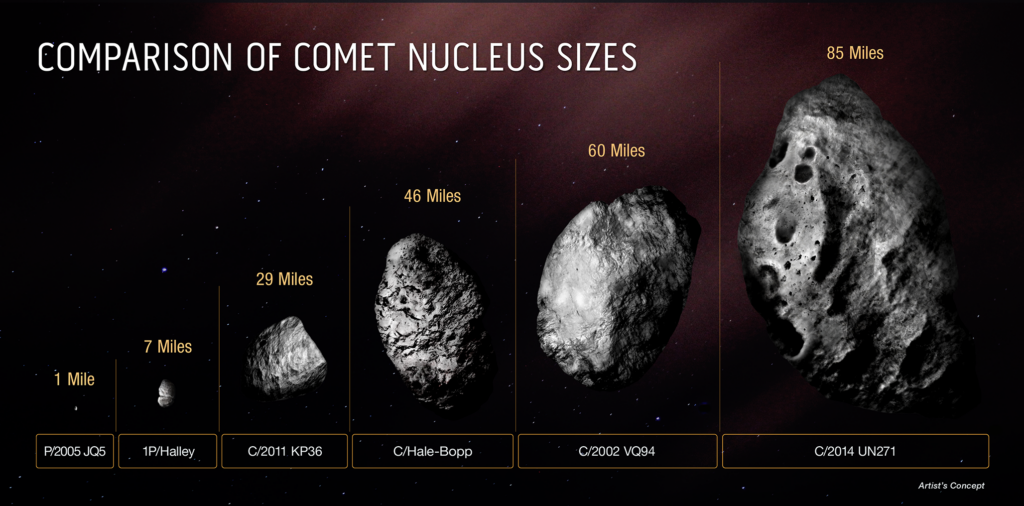The Hubble Space Telescope measured the characteristics of the comet nucleus C/2014 UN271 (Bernardinelli—Bernstein). Its data confirmed that it is the largest comet in the history of astronomy.
Tailed guest from the Oort Cloud
Comet C/2014 UN271 was discovered by astronomers Pedro Bernardinelli and Gary Bernstein during the analysis of images taken as part of the DES (Dark Energy Survey) in the period from 2013 to 2019. It was first noticed in the frames received in October 2014. At that time, the comet was at a distance of 29 au from the Sun, which is comparable to the distance to Neptune.
The discovery immediately attracted the attention of the scientific community. Firstly, C/2014 UN271 arrived from the Oort Cloud. This is the name of a hypothetical spherical region of the Solar System, which is the source of long-period comets. Calculations showed that the previous aphelion of the object lay at a distance of 39.4 thousand au from the Sun. A new visit will change the orbit of the comet. The value of its aphelion will increase to 54.6 thousand au (0.86 light years), and the orbital period will grow from 3 to 4.5 million years.
And secondly, immediately after the discovery, it became clear that C/2014 UN271 is a very large object. Initially, astronomers even believed that it could be a dwarf planet, but later they still managed to detect signs of its cometary activity.
Dimensions of Comet C/2014 UN271
To determine the size of comet C/2014 UN271, the researchers used the Hubble telescope. It turned out to be a very difficult task. Currently, the tailed guest is located at a distance of about 3 billion km from Earth, so even the technical capabilities of the orbital observatory are not enough to directly examine its nucleus. The situation is further complicated by a coma. This is the name of the shell of dust and gas surrounding the nucleus of C/2014 UN271.

Therefore, the researchers created a computer model of a comet coma, compared it with Hubble images and then “subtracted” the coma glow from them, leaving only the light from the nucleus. To improve accuracy, scientists also used data from the ALMA radio telescope complex, which introduced restrictions on the maximum size and reflectivity (albedo) of the comet.
As a result, the scientists received the following assessment. The diameter of the nucleus of comet C/2014 UN271 (Bernardinelli — Bernstein) is 135 km with a mass of 500 trillion tons. The available data also suggest that it has an even smaller albedo than previously thought. According to astronomers, the comet is blacker than coal. Most likely, this is due to the organic substances covering its surface.
Thus, C/2014 UN271 is the largest tailed guest that astronomers have ever observed. The previous record holder was comet C/2002 VQ94, whose diameter was estimated at 100 km.

Fortunately, C/2014 UN271 poses no threat to Earth. It will not come closer to Earth than 1.5 billion km. The comet will pass the perihelion of its orbit in early 2031, after which it will embark on a long journey to the Oort cloud. The next visit of C/2014 UN271 to the inner part of the Solar System will take place in 4.5 million years.
Recall that astronomers have recently suggested that the Ryugu asteroid may be the nucleus of a “burnt out” comet.
According to https://www.nasa.gov
Follow us on Twitter to get the most interesting space news in time
https://twitter.com/ust_magazine

